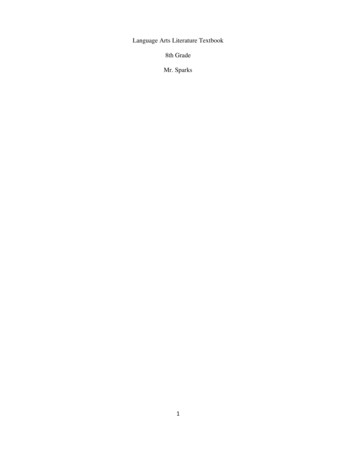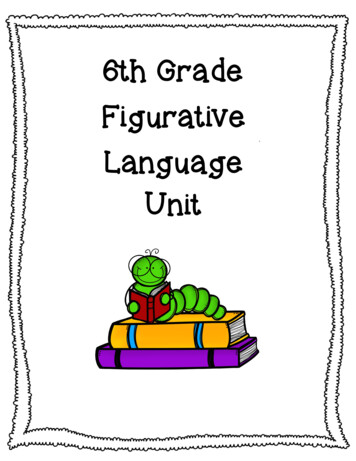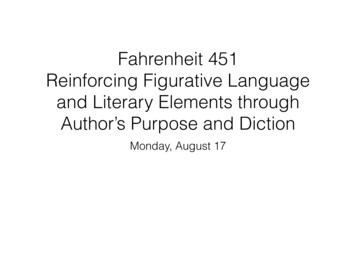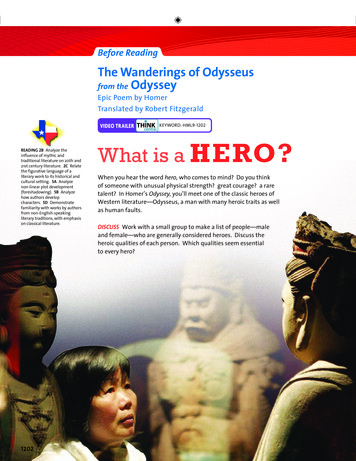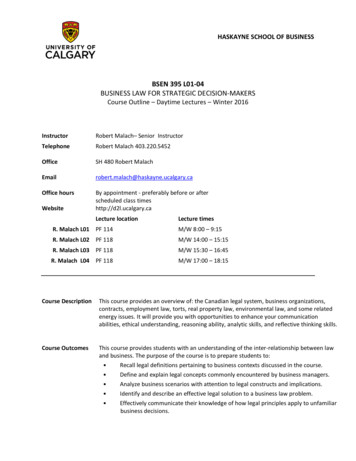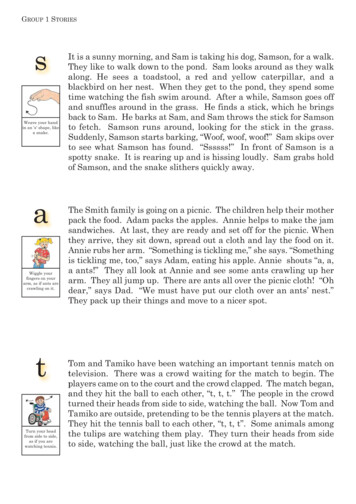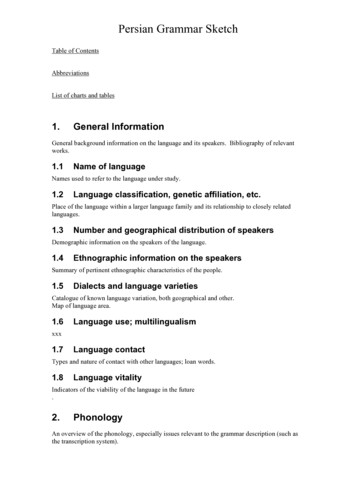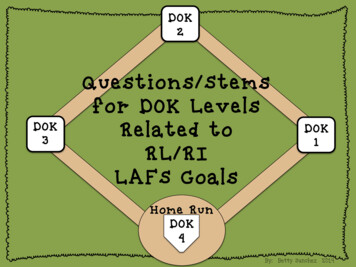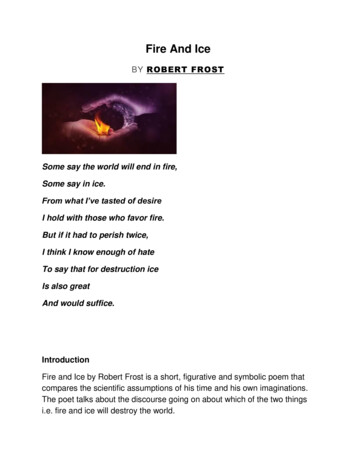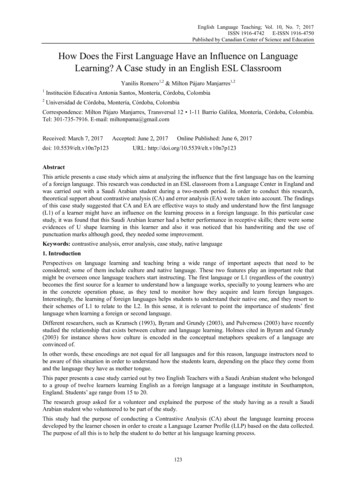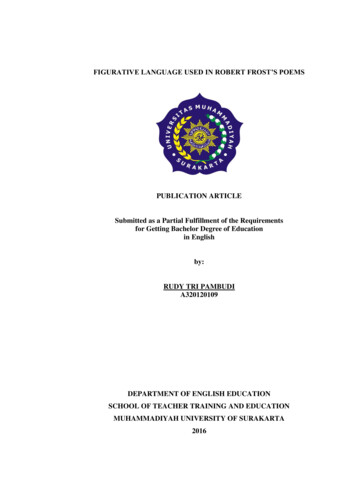
Transcription
FIGURATIVE LANGUAGE USED IN ROBERT FROST’S POEMSPUBLICATION ARTICLESubmitted as a Partial Fulfillment of the Requirementsfor Getting Bachelor Degree of Educationin Englishby:RUDY TRI PAMBUDIA320120109DEPARTMENT OF ENGLISH EDUCATIONSCHOOL OF TEACHER TRAINING AND EDUCATIONMUHAMMADIYAH UNIVERSITY OF SURAKARTA2016
i
i ii
i iii
FIGURATIVE LANGUAGE USED IN ROBERT FROST’S POEMSABSTRAKPenelitian ini memiliki dua tujuan utama yang diusulkan oleh peneliti, yaitu,(1) untuk mengidentifikasi jenis-jenis bahasa kiasan yang terkandung dalampuisinya Robert Frost dan, (2) untuk mengetahui makna tersirat dari bahasakiasan yang terkandung di dalam puisinya Robert Frost. Jenis penelitian iniadalah penelitian deskriptif kualitatif. Sumber data penelitian ini diambil daripuisi karya Robert Frost. Mengenai teknik pengumpulan data, penelitimenggunakan dokumentasi dengan mempelajari secara mendalam tentangpuisi-puisi karya Robert Frost. Maka peneliti mengklasifikasikan data ke dalambahasa kiasan menggunakan teori Perrine Lawrence dan ilmuwan lain yangmendukungnya. Sementara mengenai makna tersirat dari bahasa kiasan yangdigunakan dalam puisi karya Robert Frost ini, peneliti menggunakan teori dariGeoffrey Leech tentang jenis makna dan teori ilmuwan lainnya yangmendukungnya. Hasil dari penelitian menunjukkan bahwa dalam puisi karyaRobert Frost, ada enam jenis bahasa kiasan yang digunakan yaitu;personifikasi, methapora, simbol, ironi, hiperbola, dan apostrof. Terkait denganmakna tersirat dari bahasa kiasan yang digunakan dalam puisi, penelitimenemukan empat jenis makna tersirat yaitu; makna konseptual, maknakonotatif, makna gaya dan makna afektif.Kata kunci: bahasa kiasan, makna tersirat,Robert Frost, puisi.ABSTRACTThis research has two major objectives proposed by the researcher, they are,(1) to identify the types of figurative language used in Robert Frost’s Poemsand, (2) to find out the implied meaning of figurative language used in RobertFrost’s Poems. The type of this research is descriptive qualitative. The datasource of this research is taken from the poems by Robert Frost. Regardingwith the method of collecting the data, the researcher applies documentationby studying deeply on the poems by Robert Frost. Then the researcher clasifiesthe data using Perrine Lawrence’s theory of figurative language and otherscientists that support it. Whilst regarding the implied meaning of thefigurative language used in Robert frost’s Poems, the researcher uses thetheory of Geoffrey Leech of types of meanings and other scientists’ theoriesthat support it. The result of the study indicates that in Robert Frost’s Poems,there are six types of figurative language used namely; personification,methapor, symbol, irony, hyperbole, and apostrophe. Closerly related to theimplied meanings of figurative language used in the poems, the researcherfinds four types of implied meanings namely; conceptual meaning, connotativemeaning, stylistic meaning and affective meaning.Key Words : figurative language, implied meaning, Robert Frost, poems.1
A. INTRODUCTIONLanguage is one of the crucial tools of human beings to communicate withone another. It may represent the explicit and implicit feelings and thoughts.Language could either be in the written or spoken form. Whatever the form it is,it may consist of speech sounds, letters, words, phrases, clauses, which may beconfigurated into larger forms. We use all these forms in order to make otherpeople understand us. Through language, people can enter the globalcommunity.Figurative language is language that uses words or expressions with ameaning that is different from the literal interpretation. When the writer usesliteral language, he or she is simply stating the facts as they are. Figurativelanguage, in comparison, uses exaggerations or alterations to make a particularlinguistic point.Figurative language means that expressing something in another way torefer one thing by giving the implied meaning. It is often used in literary worksto demonstrate the creativity of the author and the beauty of language itself.Besides, it is also one of the ways to interpret the meaning hidden in the literaryworks. Figurative language in the song could make the readers understand thatlyrics of the song can describe messages that must be known by learning themdeeply in terms of categories.Figurative language is commonly applied in literary works. One of theliterary works is poetry. With the assumption that figurative language is oftenused in poetry, this thesis will discuss particularly the application of figurativelanguage used in the Robert Frost’s Poems. By discussing figurative language inpoetry, it can be analyzed how the writer’s efforts to attract the attention of thereaders or listeners through the use of figurative language which carries theintended meaning that is not explicitly expressed.The figurative language can befound in many literary works. In this research, the researcher analyses figurativelanguage used in Robert Frost’s poems.The purposes of this research are to: (1)To identify the types of figurative language used in Robert Frost’s poems, andTo describe the Implied Meanings of figurative language used in Robert Frost’spoems.B. RESEARCH METHODThe type of the research is descriptive qualitative. According to Ali (Jauharin,2014) states that descriptive qualitative research is a type of research whichresult the descriptive data in the form of written or oral words from observedobject. Descriptive qualitative is applied to solve the problem by collecting,classifying, analyzing, and describing a certain situation objectively. It isqualitative research because the researcher analyzed the data in the form ofword. The researcher used descriptive method because he analyzed the data andthen describe the finding to answer the research question.The data are line or stanza contained in Robert Frost’s Poems. There are 24data of figurative language in Robert Frost’s Poems. The data source are the fourselected poems by Robert Frost.2
Related to the focus of the study in the first chapter, it suggests twosteps how the researcher describes the technique of analyzing the data :Step 1 focusing on the types of figurative language :a. The researcher tries to describe the types of figurative language usedin Robert Frost’s Poems based on the Perrine Lawrence’s theory offigurative language and other scientists that support it.b. The researcher then classifies the types of figurative language used inthe four selected poems in Robert Frost’s poems using PerrineLawrence’s theory.c. The researcher then describes furthur why the utterance in the poembelongs to one type of figurative language and others by using PerrineLawrence’s theory.Based on the table about the types of figurative language, theresearcher found six types of figurative language in Robert Frost’s poemsnamely: 37,50% of personification, 29,16% of symbol, 16,66% ofmethapor, 8,33% of hyperbole, 4,16% of irony, and 4,16% of apostrophe.The amount of data found in Robert Frost’s poems is 24. The majority offigurative language types used in Robert Frost’s poems is personificationwhich has 9 out of 24 (37,50%).Step 2 focusing on the implied meaning of figurative language:a. The researcher tries to describe the implied meaning of figurativelanguage used in Robert Frost’s poems based on the meaning theoryof Leech.b. The researcher tries to analyze the Robert Frost’s poems by using thetheories which are already explained in advance.c. The researcher then explains further the content and context of thefigurative used in the poems based on the theory being used.The researcher found four types out of seven of the implied meaningin Robert Frost’s Poems namely: 45,83% of connotative meaning,37,50% of stylistic or social meaning, 12,50% of affective meaning, and4,16% of conceptual meaning.C. RESULT AND DISCUSSIONThis subchapter discusses the result of the research and discussion. Theresults of the research are as follows:1. Types of Figurative Language3
2. Table 4.13. Types of Figurative LanguageResultsNo.Types ofFigurative Language(s)Examples anted wear,1.Personificationyour lighttonguestalking aloud.Road2.Symboldiverged, mylittle horse,bells a shake.My sash islowered, a3.Methaporwindowflower, awinter breeze.Morning4.Hyperbolefound thebreeze,woods fill up.5.IronyWith a sigh.Tree at my6.Apostrophewindow,window tree.TotalBased on the table about the types of figurative language, theresearcher found six types of figurative language in Robert Frost’s poemsnamely: personification, symbol, methapor, hyperbole, irony andapostrophe. There are actually twelve types of figurative language basedon Lawrence Perrine’s Theory. However the researcher does not find4
simile, understatement, allegory, synecdoche, paradox, and metonymy inRobert Frost’s poems. Figurative Language has been mentioned above,there are 37,50% of personification, 29,16% of symbol, 16,66% ofmethapor, 8,33% of hyperbole, 4,16% of irony, and 4,16% of apostrophe.The amount of data found in Robert Frost’s poems is 24. The majority offigurative language types used in Robert Frost’s poems is personificationwhich has 9 out of 24 (37,50%).The previous research related to this study was conducted by Weny,UMS, (2011). The result of her research of the types of FigurativeLanguage in New Tastement are as follows : simile, methapor,personification, apostrophe, paradox, synecdoche, hyperbole, and symbol.The research conducted by Weny above has some differences withthis research. Even though using the same theory, the result of the researchby Weny has 8 types of figurative language out of 12, whilst this researchhas 6 types of figurative language out of 12.The researcher conducted from international journals has somedifferences with this research. Another researcher found related to thisresearch conducted by Mathias Benedek et al., University of Graz (2014).The result of the study is this study provides a first investigation of theneural correlates of figurative language production, and points to animportant role of left prefrontal and lateral parietal brain regions for thegeneration of new metaphors. The present study examined the neuralcorrelates of figurative language production.The next journal is written by Do Long Giang and Chung Inho,University of Tsukuba (2015). The result of the study is this studyexamined the comprehension of figurative language of 215 hearingimpaired children at special primary schools, and 557 hearing children atregular primary schools in Vietnam. The figurative language tests weredeveloped using idioms and proverbs in the Vietnamese languagetextbooks from grade 2 to grade 5 of primary schools.The next journal is written by ElahehRasoulia and Ali Rahimi, IslamicAzad University of Bandar Abbas (2015). The result of the study is thisstudy investigated the integral role of religion and culture in translation ofhumor from English Christian short stories into Persian. The main focuswas to discover how figurative languages could be transferred from sourcetext into target text.The next journal is written by Ana Roldán-Riejos and GeorginaCuadrado (2015). The result of the study is this study proves thatengineering discourse is highly metaphoric and borrows from multiplemetaphoric domains other than the typical engineering jargon. This paperhas established the interrelation of conceptual, linguistic and visualmetaphor.The next journal is written by Antonio Reyes, PaoloRosso,andDavideBuscaldi, Universidad Politécnica de Valencia (2012).The result of the study is this study is focused on analyzing two playful5
domains of language: humor and irony, in order to identify key valuescomponents for their automatic processing.The last journal is written by Dai Yingli et al., Tsinghua University(2015). The study focuses on the ways of modeling the figurativecomponent of the concept of “language” in Russian and Chinese. Theconcept is represented in lexical metaphorical nominations of speech,talking and the talking person.In this study, the researcher has found differences with existinginternational journals, because only in this study that discusses the poem.2. Types of Implied Meaning in Robert Frost’s poems.Based on the analysis above, the following table 4.2 is the summaryof the data of implied meaning in Robert Frost’s Poems.Table 4.2Types of Implied Meanings used in Robert Frost’s PoemsResultsTypes of(s)No.ExamplesMeaning% And that hasmade all the1.Connotative Meaningdifference,1145,83%937,50%312,50%my sash islowered.Wantedwear, your2.Stylistic Meaninghead, yourlight tonguestalkingaloud.With a sigh,woods fill3.Affective Meaningup, morningfound thebreeze.6
Tree at my4.Conceptual Meaningwindow,14,16%24100,00%window treeTotalBases on the table above about the types of implied meaning inRobert Frost’s Poems, the researcher found four types out of seven of theimplied meaning in Robert Frost’s Poems namely: connotative meaning,stylistic or social meaning, affective meaning, and conceptual meaning. Thereare actually seven types of implied meaning based on Goeffrey Leech’stheory. However the researcher does not find collocative meaning, thematicmeaning, and reflective meaning in Robert Frost’s Poems. As it has beenmentioned above in the table that there are 45,83% of connotative meaning,37,50% of stylistic or social meaning, 12,50% of affective meaning, and4,16% of conceptual meaning. The total data are 24 found and analyzed intothe types of implied meaning used in Robert Frost’s Poems.This study aimsto find the implied meaning used in Robert Frost's poems. it is different whencompared with the existing international journals.D. CONCLUSIONHaving discussed the finding, here the researcher would like to draw aconclusion of the analysis.1. The Types of Figurative LanguageThe researcher uses Perrine Lawrence’s theory to find out the types offigurative language in the poems. After taking and classifying the data basedon their categories of figurative language, the researcher then jumps into aconclusion that Robert Frost’s Poems use some figurative language. There arepersonification, symbol, methapor, hyperbole, irony and apostrophe.Therefore, the researcher does not find allegory, simile, metonymy,synecdoche, paradox and understatement in the poems. The top figurativelanguage used in Robert Frost’s Poems is personification. Personification isused in the poems to mainly state what means more than what it is.2. The Types of MeaningThe types of meaning contained in the figurative language used inRobert Frost’s Poems consist of: conceptual meaning, connotative meaning,affective meaning and stylistic meaning. The selected poems of Robert Frostare all about the journey and love of Robert Frost. Therefore, the researcherdoes not find reflective meaning, collocative meaning and thematic meaningof the poems. The top implied meaning used in Robert Frost’s Poems isconnotative meaning.7
DEDICATIONThis research paper is wholly dedicated to the greatest ones AllahSWT, his beloved mom, dad, sisters and friends.BIBLIOGRAPHYBenedek et al, Mathias. 2014. “Creating Metaphors: The Neural Basis ofFigurative Language Production”.NeuroImage90.99–106.University of Graz, 8010 Graz, AustriaFrost, Robert. 1939. Collected Poems of Robert Frost. New York: HalcyonHouse Garden City.Giang, Do Long and Inho, Chung. 2015. “Comprehension of FigurativeLanguage by Hearing ImpairedChildren in SpecialPrimary Schools”. Procedia - Social and Behavioral Sciences 191 506 – 511.University of Tsukuba, JapanJauharin, Khaqiqotul. 2014. Directive In English Translationof Qur’an SurahAl-Baqarah by Abdullah Yusuf Ali.Unpublished Research Paper.Kudus: University of Muria Kudus.Leech, Geoffrey. 1974. Semantics: The Study Of Meaning. England: HarmonsWorth, Penguins Book.Leech, Geoffrey. 1983. Prinsip-prinsip Pragmatik. Jakarta:UI Press.Lonanda, Fitria. 2013. The Use of Figurative Language In Characterization ofThe Nightingale and The Rose Short StoryBy Oscar Wilde. Padang:Andalas University.Perrine, Laurence. 1977. Sound and Sense: An Introduction to Poetry. HarcourtBrace Jovanovich.Rasouli, Elaheh and Rahimi, Ali. 2015. “The Effects Of Religion OnTranslating Humor From English IntoPersian ThroughFigurative Language”.Procedia - Social and Behavioral Sciences 192 453 –459.Islamic Azad University of Bandar Abbas, BandarAbbas, IranReyes, Antonio, Rosso, Paolo and Buscaldi, Davide. 2012. “From HumorRecognition to Irony Detection:The Figurative Languageof Social Media”.Data & Knowledge Engineering 74.1–12.Universidad Politécnica de Valencia, Camino de Vera, s/n 46022, Valencia,Spain8
Roldán-Riejos, Ana and Cuadrado, Georgina.“Metaphor and FigurativeMeaning Construction in Science andTechnology (English andSpanish)”.Procedia - Social and Behavioral Sciences 212 ( 2015 ) 271 – 277.Dept. of Linguistics Applied to Science & Technology, C/Prof.Aranguren, s/n , UPM, Madrid28040, (Spain)Weny, E.S. 2011. A Pragmatics Analysis Of Figurative Language Used InRevelation Bible In New Testement:Unpublished ResearchPaper. Surakarta: Muhammadiyah University of Surakarta.Yingli et al, Dai. 2015. “Metaphors for Language and Speech in Russian andChinese:a Comparative Study”.Procedia - Social andBehavioral Sciences 200 574 – 578. Tsinghua University9
Figurative language in the song could make the readers understand that lyrics of the song can describe messages that must be known by learning them deeply in terms of categories. Figurative language is commonly applied in literary works. One of the literary works is poet
